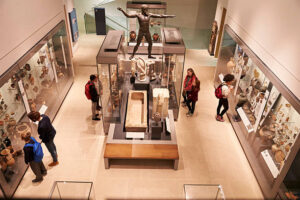You may have seen all sorts of weird and beautiful objects produced by 3-D printers: candy bars, vinyl records, medical attachments, toy figurines, and even pop-up buildings are some of the items that have been used to show off the potential of these printers. Now the nascent technology is moving into the events space, promising to shake up how events are put together and the experiences they offer.
Take this year’s South by Southwest (SXSW) festival, for example. Visitors to the Oreo booth, dubbed the “Trending/Vending” machine, were treated to cookies finished off with a customized edible design that was 3-D printed on-site using several tubes of icing as “ink” cartridges. Attendees waited up to two hours to get their personalized snacks. Bonin Bough, vice president of global media and consumer engagement at Mondelez (the company that owns Oreo), declared the initiative “a huge success.” The setup offered “unique experiences for consumers that they could never have any other way,” Bough told Adweek. But this concept doesn’t have to be limited to novelty snacks. Imagine an event invitation, a prototype toy, or a phone case made to your specification in a matter of minutes, printed by a vendor at an exhibition without any need for orders or delivery.
Saks Fifth Avenue brought a MakerBot 3-D printer to one of its in-store events during the Christmas rush. The device was used to print snowflakes and tree toppers for the festive display in Saks’ flagship store. Customers who spent $150 or more were eligible to receive a 3-D-printed snowflake design, another demonstration of how this technology can create instant, personalized products in any venue.
3-D printing works by depositing plastic, metal, sugar, or something else layer by layer in a process often referred to as additive manufacturing. Printers typically use a computer-aided design drawing as a starting point. Eventually, the technology could replace traditional casting, forging, and manufacturing methods on a larger scale. For now, it’s at the smaller novelty level that companies are getting involved, but there’s the potential for a revolution here.
3-D Printing and Events
There are two trends to watch for when it comes to 3-D printing at events: in the production of materials and decor on-site and in the products that can be offered to attendees. Consider being able to 3-D extra print seating or more marketing materials on-demand to match the number of guests.
While the 3-D printing industry is moving quickly, it will still be long before we see it appear at conferences and meet-ups. “I can’t necessarily agree that 3-D printing will disrupt events and conferences anytime soon,” says Terry Wohlers of Wohlers Associates, a 3-D printing consultancy firm. “However, the technology will undoubtedly be used to print objects and decorations that gain attention, and it’s great for producing giveaway products, such as memory sticks or flash drives with your organization’s name on them, as well as other low-cost, semi-custom items.”
But early signs of disruption are there. “I’ve seen a 3-D-printed tree set up at a show, and it was impressive,” says Wohlers. “Another attraction is a 3-D photo booth: a person’s head and face are 3-D scanned, and then a smaller model is produced. Also, accessories can be 3-D printed for fashion models, which would be a good way to draw attention to an exhibit.”
Part of the appeal of 3-D printing technology is that it opens up so many possibilities and permutations. As with a conventional printer, organizations and individuals have a blank page to work with and a range of materials to choose from. The custom-made USB flash sticks that Wohlers mentions—or the unique Oreo toppings previously noted—could just as quickly be name badges, scale models, or jewelry. Within a year or two, the goodie bags your attendees take home from a conference could be fresh from the production line and much more personalized.
The 3-D Printing Experience
Julie Friedman Steele helps run The 3-D Printer Experience in Chicago. Initially intended as a short-term pop-up store, the venue has gained significant traction over the past twelve months and will soon be relocating to larger premises. The 3-D Printer Experience hosts regular workshops and classes, as well as 3-D-themed teambuilding and customized events for businesses, using its large in-house selection of printers and accessories. It also creates custom-made 3-D objects for individuals and companies.
Steele says there has been considerable interest from companies looking to test the waters with 3-D printing. “The first thing people want to do is make their logo 3-D,” she says. “What they want to know is how 3-D printing will affect their lives. They want something that’s customized for them.”
Visitors to The 3-D Printer Experience can see one of their designs made into a physical object, watch a demonstration of the technology, or learn how the hardware turns concept designs into reality.
Steele compares the 3-D printing revolution with the Internet. Being able to share information globally instantly has made a massive difference to events, businesses, and marketing. Still, physical objects and manufacturing processes are now involved rather than just data streams. “I’m most excited about the fact that we can create sustainable communities around 3-D printing and that it creates a whole different future that we never thought was possible,” says Steele. “Now we can send digital files anywhere in the world and manufacture that locally. It is a huge deal that you can develop a creative idea, share it with somebody else, and both have it as a physical object.”
Events and Exhibitions
Steele says she’s seen 3-D printing technology used extensively at events and exhibitions, from chocolate molds to customized ice cubes. “You can do a ton of things. I think it’s a great idea for events because its novel, and people like novelty,” she says. “We’re excited about NeoCon, where we are partners with the International Interior Design Association. We are working with them to create objects for their booth and existing furniture using 3-D printing. And we’re also giving out custom hashtag pieces for them to pass out, so it’s moving beyond the small giveaway items to more meaningful things.”
It’s also about democratization. Just as the humble inkjet printer is an accessible, portable printing press, the 3-D printer gives anyone a mobile manufacturing plant. “I think we’re going to see more power given to small businesses and the general public at large,” says Steele. “Larger corporations will lose their edge a little bit because everybody has access to the same technology. The amount of innovation an entire country or everybody on the planet can have is way more powerful than the Fortune 100 companies. People can create whatever they want, so we’ll see some cool innovations.”
Today, creating large objects with 3-D printing technology is a slow process. But in the not-so-distant future, 3-D printers could substantially change the shape of events. Things can be transported across the globe instantly, printed on-site rather than ordered in advance, and printed on-demand to cut down on waste or to create extra capacity. From furniture to cookies, that has enormous implications.


Average Rating